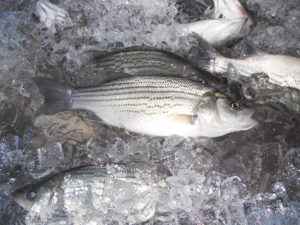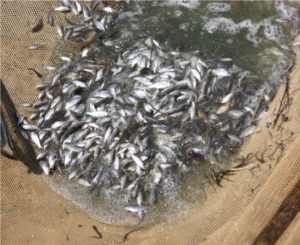Striped Bass (Wild, Domesticated, and Hybrid)
go.ncsu.edu/readext?630418
en Español / em Português
El inglés es el idioma de control de esta página. En la medida en que haya algún conflicto entre la traducción al inglés y la traducción, el inglés prevalece.
Al hacer clic en el enlace de traducción se activa un servicio de traducción gratuito para convertir la página al español. Al igual que con cualquier traducción por Internet, la conversión no es sensible al contexto y puede que no traduzca el texto en su significado original. NC State Extension no garantiza la exactitud del texto traducido. Por favor, tenga en cuenta que algunas aplicaciones y/o servicios pueden no funcionar como se espera cuando se traducen.
Português
Inglês é o idioma de controle desta página. Na medida que haja algum conflito entre o texto original em Inglês e a tradução, o Inglês prevalece.
Ao clicar no link de tradução, um serviço gratuito de tradução será ativado para converter a página para o Português. Como em qualquer tradução pela internet, a conversão não é sensivel ao contexto e pode não ocorrer a tradução para o significado orginal. O serviço de Extensão da Carolina do Norte (NC State Extension) não garante a exatidão do texto traduzido. Por favor, observe que algumas funções ou serviços podem não funcionar como esperado após a tradução.
English
English is the controlling language of this page. To the extent there is any conflict between the English text and the translation, English controls.
Clicking on the translation link activates a free translation service to convert the page to Spanish. As with any Internet translation, the conversion is not context-sensitive and may not translate the text to its original meaning. NC State Extension does not guarantee the accuracy of the translated text. Please note that some applications and/or services may not function as expected when translated.
Collapse ▲Striped Bass production in North Carolina is focused using the Hybrid Striped Bass, which is a cross between White Bass and Striped Bass (Morone chrysops x Morone saxatilis). Hybrid Stripped Bass are considered to be “non-naturally” accuring becuase the White Bass and Striped Bass do not hybradize naturally. When a female White Bass and a male Striped Bass are crossed, the offspring are refered to as reciprocal crosses hybrids or more commonly as Sunshine Bass. When a female Striped Bass and a male White Bass are crossed, the offspring are refered to as original crossed hybrids or Palmetto Bass. Hybrid Striped Bass are the fourth most farmed fin fish in the US, behind only catfish, salmonids, and tilapia. In North Carolina this industry accounts for approximately 3,500,000 lbs annual production with a farm-gate value of nearly $14,000,000. Located in our coastal plain region, most production occurs in earthen ponds.
More recently, research at NCSU is showing improved production potential for domesticated Striped Bass, compared to the hybrid. Work in this area is ongoing with area producers conducting on-farm trials with much success.
Other NCSU Striped Bass Resources
For more information on Striped Bass production please see:
- SRAC 0300: Hybrid Striped Bass: Biology and Life History
- SRAC 0301: Hybrid Striped Bass: Hatchery Phase
- SRAC 0302: Hybrid Striped Bass: Fingerling Production in Ponds
- SRAC 0303: Hybrid Striped Bass: Pond Production of Foodfish
- SRAC 3000: Comparison of Costs of Different Hybrid Striped Bass Production Systems in Ponds
- SRAC 3001: Feeds and Feeding of Hybrid Striped Bass




